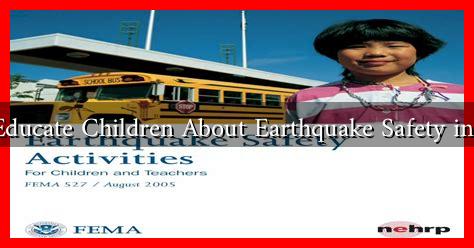-
Table of Contents
- How to Educate Children About Earthquake Safety in Lebanon
- The Importance of Earthquake Education
- Effective Strategies for Teaching Earthquake Safety
- 1. Interactive Workshops
- 2. Educational Materials
- 3. School Curriculum Integration
- Case Studies and Success Stories
- Statistics on Earthquake Preparedness
- Conclusion
How to Educate Children About Earthquake Safety in Lebanon
Lebanon is situated in a seismically active region, making earthquake preparedness a crucial aspect of public safety. With a history of significant seismic events, it is essential to educate children about earthquake safety to ensure they know how to respond effectively during such emergencies.
. This article explores various strategies for teaching children about earthquake safety in Lebanon, emphasizing the importance of preparedness, awareness, and practical skills.
The Importance of Earthquake Education
Understanding earthquake safety is vital for children, as they are often the most vulnerable during natural disasters. Educating them can help reduce panic and confusion, enabling them to take appropriate actions when an earthquake occurs. Here are some reasons why earthquake education is essential:
- Increased Awareness: Children who are educated about earthquakes are more likely to recognize the signs of an impending quake and understand the importance of safety measures.
- Empowerment: Knowledge empowers children to act decisively during emergencies, potentially saving lives.
- Community Resilience: Educated children can share their knowledge with family and friends, fostering a culture of preparedness within the community.
Effective Strategies for Teaching Earthquake Safety
To effectively educate children about earthquake safety, various strategies can be employed. These methods can be adapted for different age groups and learning styles:
1. Interactive Workshops
Organizing workshops in schools or community centers can provide hands-on learning experiences. Activities can include:
- Simulated earthquake drills to practice “Drop, Cover, and Hold On” techniques.
- Creating emergency kits with children, explaining the importance of each item.
- Role-playing scenarios to help children understand how to react during an earthquake.
2. Educational Materials
Utilizing age-appropriate educational materials can enhance children’s understanding of earthquake safety. Resources may include:
- Books and storybooks that explain earthquakes in a child-friendly manner.
- Videos and animations that demonstrate safety procedures during an earthquake.
- Interactive games and quizzes that reinforce learning through fun activities.
3. School Curriculum Integration
Incorporating earthquake safety into the school curriculum can ensure that all children receive essential training. This can be achieved by:
- Including earthquake safety in science lessons, discussing tectonic plates and seismic activity.
- Integrating safety drills into the school calendar, ensuring regular practice.
- Collaborating with local emergency services to provide expert-led sessions.
Case Studies and Success Stories
Several initiatives in Lebanon have successfully educated children about earthquake safety. For instance, the Lebanese Red Cross has implemented programs that focus on disaster preparedness in schools. These programs have shown positive results, with children demonstrating increased knowledge and confidence in handling earthquake situations.
Additionally, the Ministry of Education has partnered with international organizations to develop educational resources that are distributed to schools across the country. These resources have been instrumental in raising awareness and equipping children with the necessary skills to respond effectively during an earthquake.
Statistics on Earthquake Preparedness
According to a study conducted by the Lebanese Center for Research and Development, approximately 70% of Lebanese children are unaware of basic earthquake safety measures. This statistic highlights the urgent need for comprehensive educational programs. Furthermore, research indicates that communities with proactive education programs experience lower injury rates during seismic events.
Conclusion
Educating children about earthquake safety in Lebanon is not just a necessity; it is a responsibility that can significantly impact community resilience. By employing interactive workshops, integrating safety into school curricula, and utilizing engaging educational materials, we can empower the next generation to respond effectively during earthquakes. As Lebanon continues to face seismic risks, prioritizing earthquake education will ensure that children are prepared, informed, and capable of protecting themselves and others in times of crisis.
For more information on earthquake preparedness, you can visit the Lebanese Red Cross website, which offers resources and training programs aimed at enhancing community safety.





